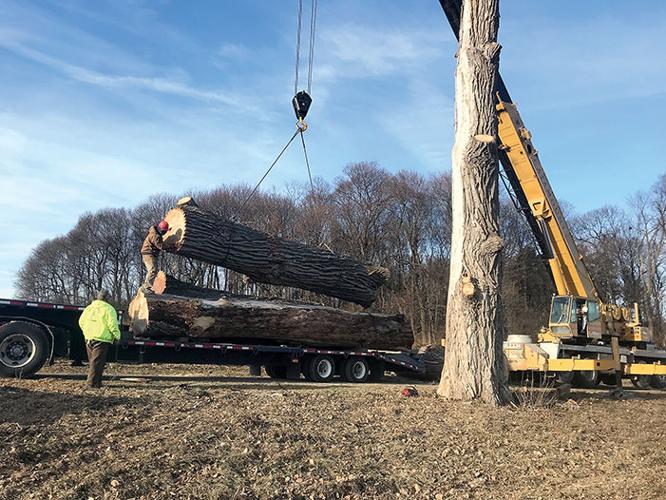By MADELINE HUGHES
It was dark when the crew of six arrived at Shelburne Farms just before 7 a.m. last Wednesday morning, one of the shortest days of the year. They were there for a big task: removing the 16 massive Eastern Cottonwood trees that have lined Poplar Drive for over a century.
“It’s crazy what took 100 years to create is gone in just a day,” said John Monks, owner of Vermont Tree Goods. His company was charged with removing the trees, taking them to his Bristol lumberyard, and giving them new life.
“Trees are living things, they don’t live forever,” he said. “We try to reuse them and help their legacy live on.”
Monks’ company is in the business of removing heirloom trees and creating them into wood products. He removed what was believed to be New England’s largest slippery elm in 2016 on Thompson’s Point in Charlotte. The Shelburne Farms project is one of the largest volume projects Monks has done.
“There are so many trees here and they are iconic,” Monks said. “There is a large community of people here at Shelburne Farms who are involved as well. Every time you come through the gate (into the farm) you can’t miss (the trees).
People had been coming up to the trees to take photos and to talk to him on and off all day, he added.
The trees had to be removed from the farm because they were at the end of their life cycles.
“They were getting old and dying back,” said Alec Webb, president of the farm. “We were concerned about branches falling. Looking at the long-term landscape planning, it was time to look at planning the next generation of (cottonwood) trees.”
The farm has worked with Heritage Landscapes in Charlotte plan how to continue the historical landscape, even though trees die and tree diseases evolve. Webb recalled elm trees by the front gate being replaced in the 1970s or 80s, adding that some have been lost to Dutch elm disease.
“Landscapes don’t stay static even on a place like the farm, which you think is static,” Webb said. “Replacing trees can be such a big change in the landscape.”
The trees had to be removed before spring, because that’s when farm staff will plant new cottonwoods in their place.
Removing the trees
In November, Treeworks of Vermont cut the branches off the cottonwood trees lining Poplar Drive and the enormous trunks were left lining the path.
“That’s a 40-foot log right there,” Monks said.
One of the largest trunks cut weighed about 2,500 pounds, he added. The trunks were just over four-feet wide.
Last week, the trunks came down one by one. The steps were the same repeated at each tree.
First, a crew member would step into the orange lift to rise to the top of branchless trunk. Then he would secure the tree to the crane.
Two other men used a two-person chainsaw to cut the tree at the bottom while the crane held the tree upright. Once the chainsaw made its way through the base of the trunk, the crane slowly laid it on the ground.
Tree bark crackled as workers wrapped chains around the trees trunks. Then, depending on the tree’s size, a crewmember used a chainsaw to cut it in half before moving it to the flatbed truck.
Three large trunk pieces could fit on the truck, the edges of the trees sawed off to make sure the trees fit snug, fitting together like puzzle pieces.
“We’re packing it to make sure it doesn’t fall off halfway to Bristol,” Monks said.
“That’s a lot of wood,” he added, gazing at the flatbed truck that hauled wood all day. The truck made three trips by 2 p.m., with half a dozen trees still standing.
Once at the company’s Bristol lumberyard, the trees will be milled into slabs for the company make into furniture.
“This story will go on for a few years. They’re going to live on in different ways and that’s cool,” Monks said as the truck pulled away, adding again, “Boy, that’s a lot of wood.”
Webb said the farm hopes to use some of the furniture created by the trees.
“For me, this has been a great community experience,” Webb said.
Multiple people have asked farm staff about the trees and they have received dozens of comments online since the trees were topped to begin the harvesting process earlier this fall.
“It’s been a community experience grieving the trees, but we realize how fortunate we are to have a connection to this place, and to see the circle of life,” Webb said.
Multiple people also sent photos to the Shelburne News during the process.
“It was shocking and eerie looking,” Diane Leary said, describing her thoughts of when she first saw the trees cut back.
She’s been going for walks at Shelburne Farms for about five years after moving to a less rural location, and sent in photos of the process. “Shelburne Farms became my happy place to go for walks and experience nature.”
“It’s sad but it’s necessary,” she said. “They were icons.”




















(0) comments
Welcome to the discussion.
Log In
Keep it clean. Please avoid obscene, vulgar, lewd, racist or sexual language.
PLEASE TURN OFF YOUR CAPS LOCK.
Don't threaten. Threats of harming another person will not be tolerated.
Be truthful. Don't knowingly lie about anyone or anything.
Be nice. No racism, sexism or any sort of -ism that is degrading to another person.
Be proactive. Use the "Report" link on each comment to let us know of abusive posts.
Share with us. We'd love to hear eyewitness accounts, the history behind an article.